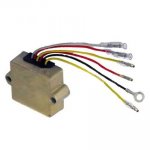rotorhead22
Seaman
- Joined
- May 19, 2015
- Messages
- 74
Good morning to all, I am new to boating and needed to seek a good source of info and found this forum which appears to be a great source. I tried using the search option for this issue, but nothing came up. I have a 1989 Sea Ray 16' Bowrider with a 100 Mercury outboard engine. We have had this boat in the gulf and have had no issues. When we went to a nearby lake, a wire broke loose from a poor crimp connecter installation (under the transom in a cubby hole) and the attached pictures are of a component that got so hot the rubber material was smoking pretty good. I disconnected the battery immediately and let things cool down. This component is on top of the engine, forward of the flywheel toward the transom. I was able to troubleshoot this issue and stripped the wires more or less by feel and twisted them together. the more cranked just fine three more times with no issues.The parts diagrams that I find state that this component is a "kit". I ordered what I thought was this component but instead received a voltage regulator which is just fine because I'm sure that this will eventually fail also. So after this long winded tale, what is he actual name of this component? T


























